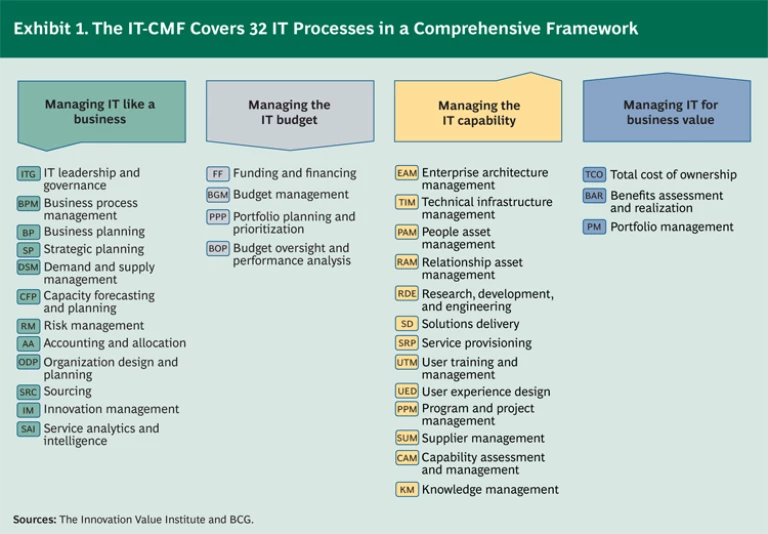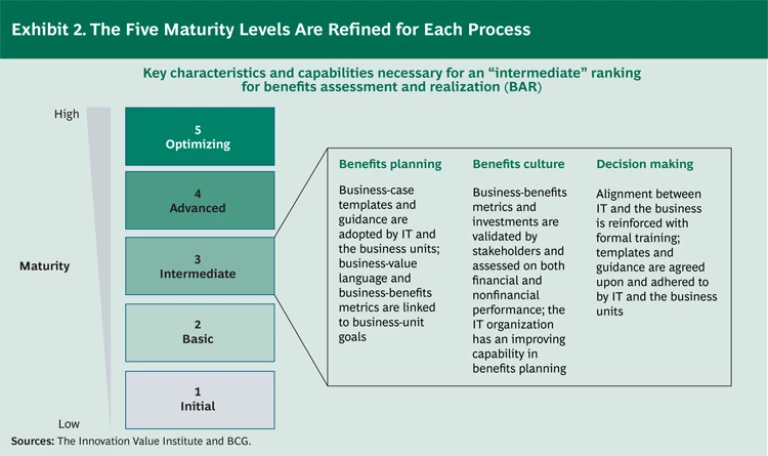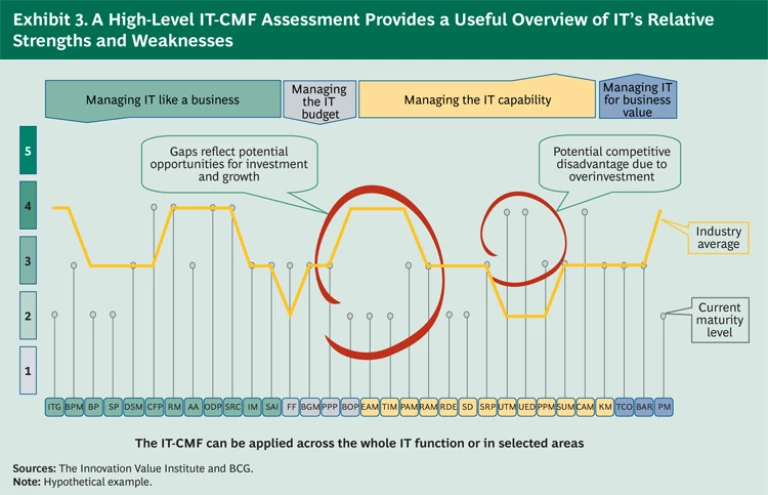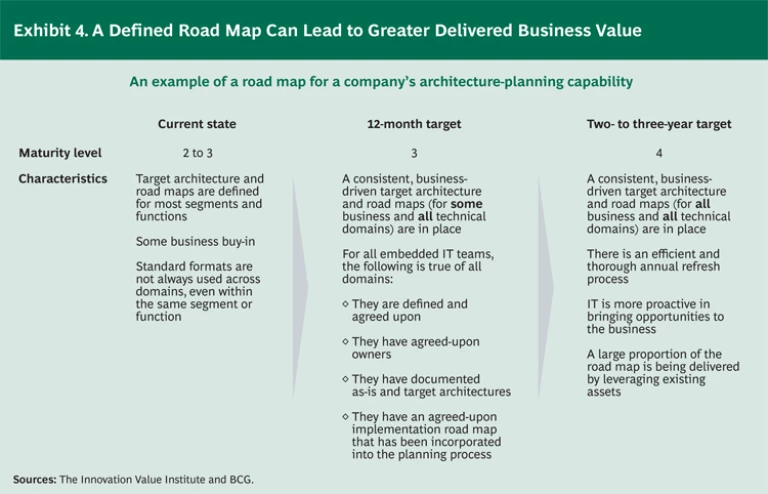After 60,000 hours of R&D and more than $10 million in investment, the Innovation Value Institute’s IT Capability Maturity Framework (IT-CMF), a state-of-the-art assessment framework designed to help IT organizations maximize their contribution to business value, is fully developed and operational. Version 1.0 launched on June 2, 2010.
What does the launch mean for CIOs and other IT leaders? It means that for the first time, they have an integrated, standardized framework for evaluating IT both strategically and from a business-value-added perspective. It means that they have a common developmental yardstick designed and tested by some of the world’s leading organizations. It means that they have an effective and credible communication platform to use in discussions with business stakeholders, including CEOs and CFOs, for describing how the IT organization is performing and what it aims to achieve.
In short, it means that IT organizations and their leaders have the means to substantially upgrade IT’s capabilities across the board and substantively improve its delivery of business value. The benefits to companies stand to be sizable.
The IT-CMF: Genesis, Design, and Evolution
I have great confidence in the Innovation Value Institute and its ability to significantly impact the future of IT—and, in so doing, to help enterprises and governments worldwide maximize the value of their IT investments."
—Justin Rattner, vice president, chief technology officer, and director, Intel Labs, Intel Corporation
The IT-CMF, for those who have not yet explored it, is the brainchild of the Innovation Value Institute (IVI). The IVI is a global consortium of leading industry, government, not-for-profit, and academic organizations whose aspiration is to establish a gold standard for managing IT for business value. Established in 2006 by Intel, The Boston Consulting Group, and the National University of Ireland, Maynooth, the IVI currently has more than 50 members, including AXA, Chevron, Ernst & Young, Google, Microsoft, and SAP. Recent additions to the IVI’s roster include Cisco and the U.S. Department of Homeland Security.
The IT-CMF incorporates elements of and builds on existing IT frameworks, such as CMMI (Capability Maturity Model Integration), COBIT (Control Objectives for Information and related Technology), and ITIL (Information Technology Infrastructure Library). But it differentiates itself in that it takes a holistic approach, covers all IT activities in a single framework, and uses an internally consistent methodology. (See “How the IT-CMF Differs from Other IT Frameworks,” below.)
How the IT-CMF Differs from Other IT Frameworks
The IT-CMF differs from other IT frameworks in several fundamental respects. First, it is comprehensive. While other frameworks focus on one dimension of IT management—for example, ITIL (Information Technology Infrastructure Library) concentrates on infrastructure and operations, while CMMI (Capability Maturity Model Integration) focuses on application development—the IT-CMF examines the full spectrum of dimensions.
The IT-CMF is also holistic and value-focused. Other frameworks tend to focus solely on IT process maturity, which by itself does not create business value. The IT-CMF, however, focuses on the business value delivered by IT and how a combination of process, skills, culture, and tools can maximize that value.
The IT-CMF is also action oriented. An IT-CMF assessment not only confirms the IT organization’s current maturity for a given capability or set of capabilities, it also defines both short- (that is, 12-month) and medium-term (that
is, two- to three-year) target maturities and the results the IT organization could expect to achieve by hitting those targets. Further, it identifies the specific steps necessary to achieve those targets, as well as appropriate metrics to use to track progress—and can provide case study examples of companies that have taken similar measures.
Finally, the IT-CMF is not disruptive. Assessments for some frameworks require armies of consultants with clipboards and can be highly disruptive to day-to-day operations. IT-CMF assessments, in contrast, can gather the necessary information and achieve a credible degree of rigor without being obtrusive.
It also distinguishes itself through its emphasis on delivering real, quantifiable results and improving business value. And those results can be considerable, based on the experiences of IVI members who have already utilized the framework for self-diagnosis and improvement. A pharmaceutical company, for example, realized an 8 percent savings in its total operating budget for technology innovation—and a 20 percent savings in its total budget for experiment execution—as a result of improved IT efficiency. The IT services and support arm of a leading insurer achieved a 96 percent reduction in setup time for new servers, with much of the improvement driven by insights gained from the IT-CMF assessment.
The framework segments the activities of a company’s IT function into four strategies or macroprocesses—managing IT like a business, managing the IT budget, managing the IT capability, and managing IT for business value. Each macroprocess is defined in significant detail and incorporates multiple processes. In all, the framework examines 32 such processes. (See Exhibit 1.)
Each process is further broken down into a number of capability building blocks. For each block, the IT-CMF defines five maturity (or developmental) levels, from “initial” to “optimizing.” (See Exhibit 2.) Assessing the maturity level of the various building blocks helps the IT organization understand its current position, make comparisons with benchmarks and peer companies, and define a target level that will maximize the generated business value for the company.
Over the course of the framework’s development, the IVI populated a database of best practices and metrics and tested and refined the framework’s methodologies via pilot assessments. Indeed, prior to the June launch, the IVI had conducted more than 100 such assessments, virtually all with leading companies from a range of industries—so the framework had been thoroughly road-tested before going public. It will continue to evolve over time. Further developments currently being planned include “lenses” that show how the IT-CMF applies to topics such as cloud computing and ecofriendly information and communications technologies.
"Cisco is very interested in using the IT-CMF to carry out an in-depth assessment of our IT operating model and capabilities. Of particular value is the ability to benchmark, identify gaps, and use the assessment to prioritize future IT investment to enhance Cisco's growth, innovation, and customer experience."
—Robbert Kuppens, CIO, European Markets, Cisco Systems
The Framework in Action
How does the IT-CMF work in practice? It offers both an introductory, high-level overview assessment and a detailed exploration of individual processes. The former, which is based on a comprehensive questionnaire and a comparison of results with industry averages, crystallizes for senior management (of both IT and the business) the IT organization’s effectiveness. (See Exhibit 3.) The overview assessment also identifies performance gaps and can help managers understand which key processes might benefit from a more in-depth examination.
The detailed assessments (which typically take from four to six weeks to conduct) give IT organizations rich insight into the current maturity levels of the targeted areas. The assessments also give IT a road map for making improvements and translating them into greater business value. (See Exhibit 4, which shows a current assessment and improvement road map for an IT organization’s architecture-planning capability.)
Intel’s own use of an IT-CMF deep dive to assess and optimize its enterprise architecture management (EAM) is illustrative. The assessment revealed that the company’s overall EAM maturity was at level 2, or “basic.” The assessment also identified specific strengths and areas for improvement. Strengths included strong governance bodies, an effective organization structure, and initiatives in place for aligning strategic and architecture plans and strengthening and standardizing methods and practices. Steps for improvement included the following:
- Architecture plans could be followed more consistently
- The EAM skills base could be broader
- The value delivered by EAM could be better measured, understood, and communicated
Communication in general between the EAM organization and the broader IT function—as well as with the business side—could be improved, yielding significant benefits
On the basis of these insights, Intel’s IT leadership was able to identify and prioritize action steps to bring the company’s EAM capabilities up to its targeted levels. These steps included instituting and tracking relevant performance metrics and sharing the results; assigning owners to specific processes to ensure accountability and continuous improvement; and establishing a common template for the development and sharing of an architecture vision and road maps. Implementation of these initiatives yielded rapid results—EAM effectiveness improved 19 percent within one year, according to Gregg Wyant, chief technology officer and general manager of strategy, architecture, and innovation within Intel’s information technology group—and it ultimately closed the gap between where EAM was, capabilities-wise, and where leadership believed it needed to be to deliver the targeted value to the company.
This assessment of the EAM function was to be an integral part of a comprehensive transformation of Intel’s IT capabilities utilizing the IT-CMF, according to Wyant. “Using the IT-CMF helped guide us to a 25 percent improvement in IT effectiveness,” he said, adding that it simultaneously enabled a 10 percent reduction in
Chevron’s IT organization used an IT-CMF detailed assessment to understand and improve its ability to support a key component of the company’s business model—innovation. The innovation management (IM) assessment (which rated Chevron’s IT organization’s overall IM capability at a level 2, or basic) looks at 14 capability building blocks, ranging from vision and strategy to metrics and measurement. The analysis identified a number of clear strengths, including a supportive culture, a well-established innovation strategy for IT that was aligned with the strategy of the business, and tools and processes that reinforce and foster creative thinking and ideation. The assessment also found several potential areas for improvement, including a need for increased seed funding, especially for new technologies; opportunities to further encourage risk-taking; and a need to better leverage collaboration.
Chevron’s IT leaders acted on the findings and recommendations—for example, by creating best-practice examples and communicating more actively to employees regarding its vision and activities—with very positive results. More broadly, IT leadership found the assessment highly valuable for facilitating internal discussions and gaining alignment on direction, prioritization, and action steps. In fact, leadership was so impressed by the overall results of the IM assessment that it proceeded to conduct assessments in two other areas—enterprise architecture management and sourcing—that it considers of vital importance.
The Model and the IVI Continue to Gain Traction
The list of companies that have had an IT-CMF assessment continues to grow, as does the number of businesses that are leveraging the IT-CMF aggressively, either as a standalone framework or in conjunction with other frameworks. Merck is using it to develop a long-term plan to develop its innovation capability. Chevron has adopted it as a unifying framework across all of its global IT operations, from those supporting exploration to those supporting distribution and sales. Chevron’s IT organization has also incorporated the framework into its performance-management system and uses it to inform its large-change efforts. And a number of leading oil and gas companies are using six processes of the IT-CMF in an integrated qualitative and quantitative benchmarking study covering their entire enterprise IT. The IVI expects the momentum to continue to grow and broaden and believes that, by 2015, more than two-thirds of all Fortune 500 companies will be using the IT-CMF as the core framework for managing their IT capability.
The IVI is also expanding its footprint via the launch of formal educational programs and materials. It recently announced the establishment of an international master’s degree along with professional diploma courses tailored for CIOs and senior IT executives. The curriculum’s focus is on how to align IT with business strategy, improve business performance, and ensure the CIO’s position at the boardroom table. The programs will be available online and through selected academic institutions in the United States and Europe.
We believe that the full launch of the IVI’s IT-CMF signals a new era in IT management and IT’s ability to drive business value. If you have not yet explored the framework or had an assessment, consider doing do. It can be a particularly worthwhile exercise if you have a general sense of where problems lie but need confirmation. It can also be highly useful for a new CIO seeking to understand the strengths, weaknesses, and drivers of the IT organization’s performance.











